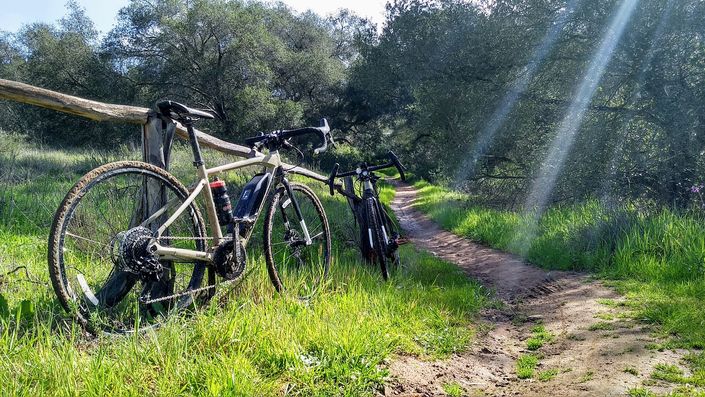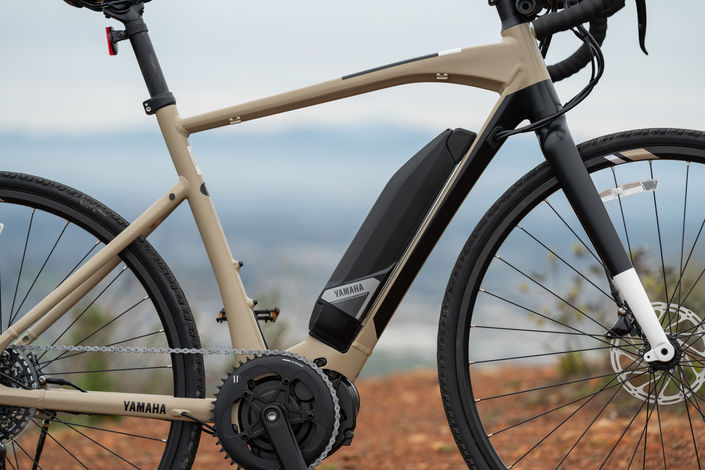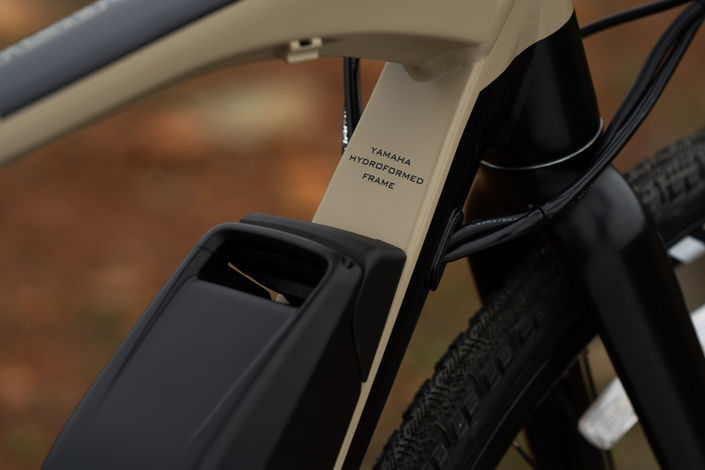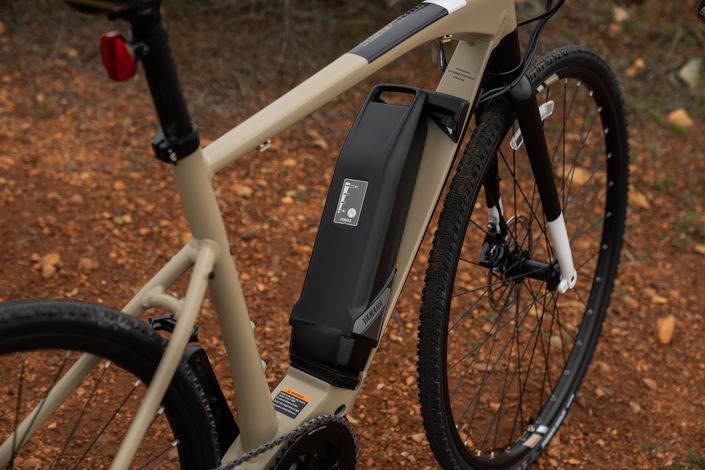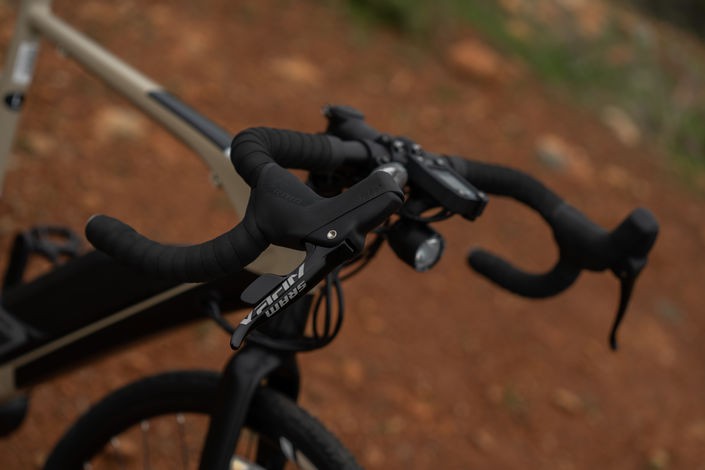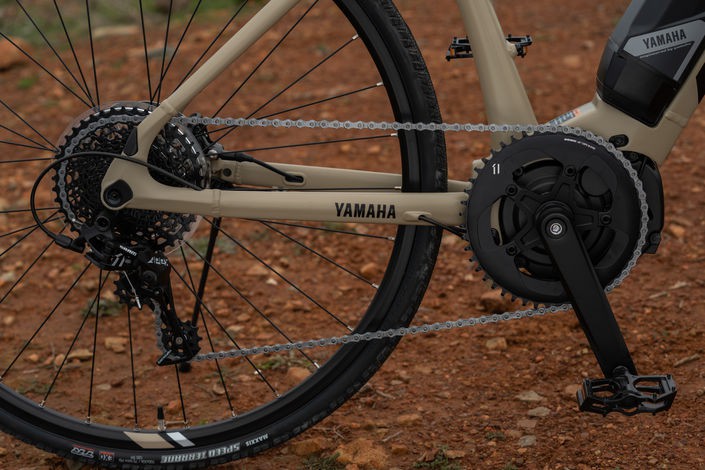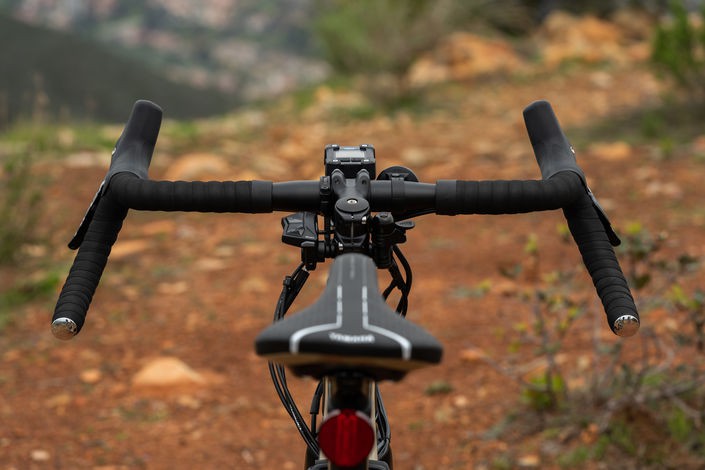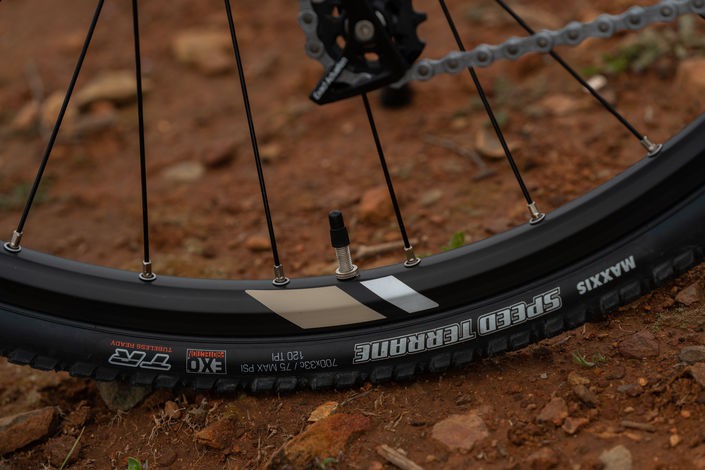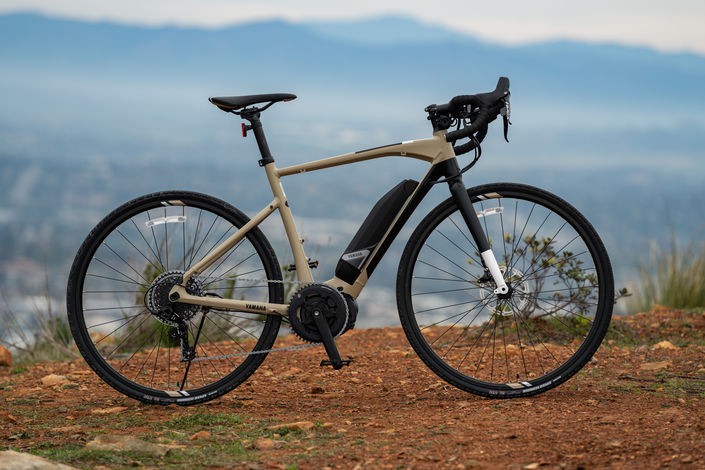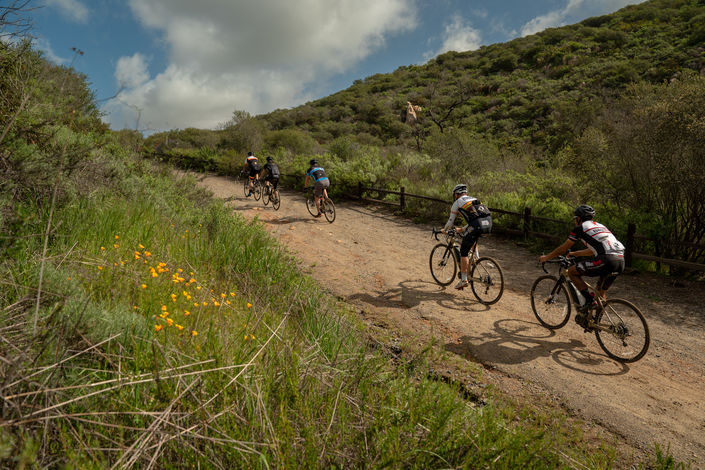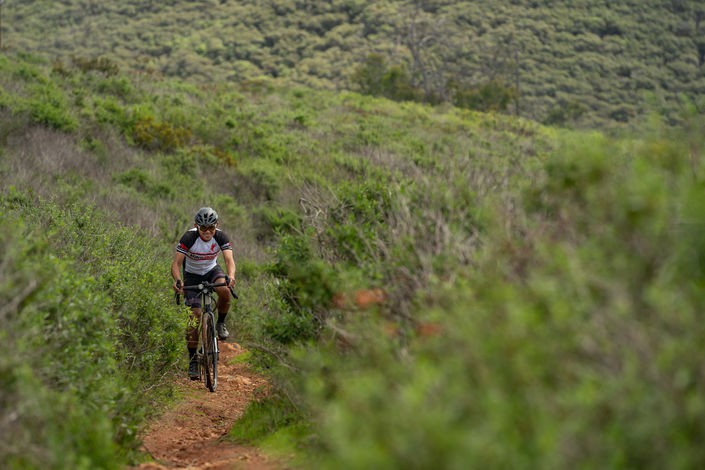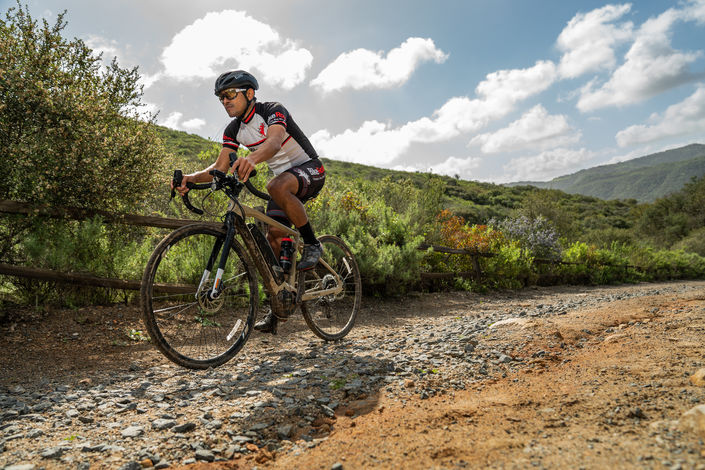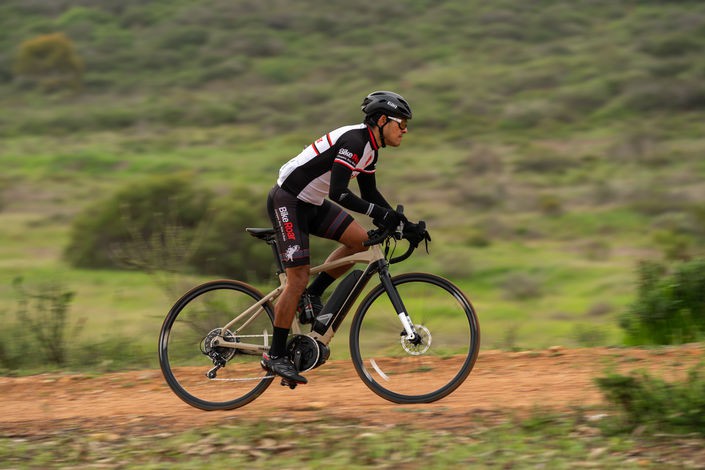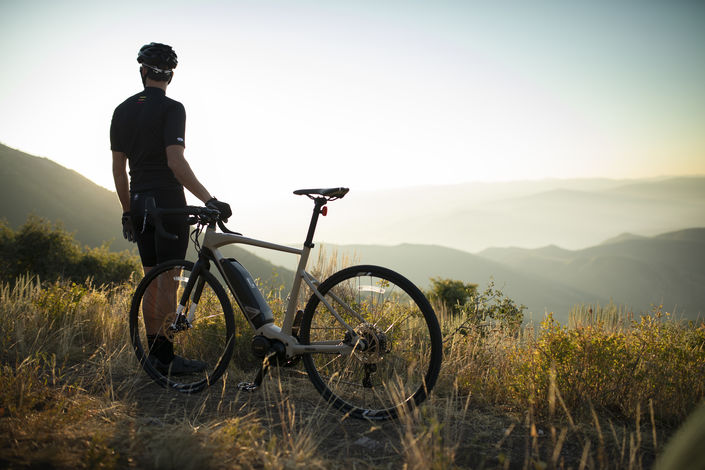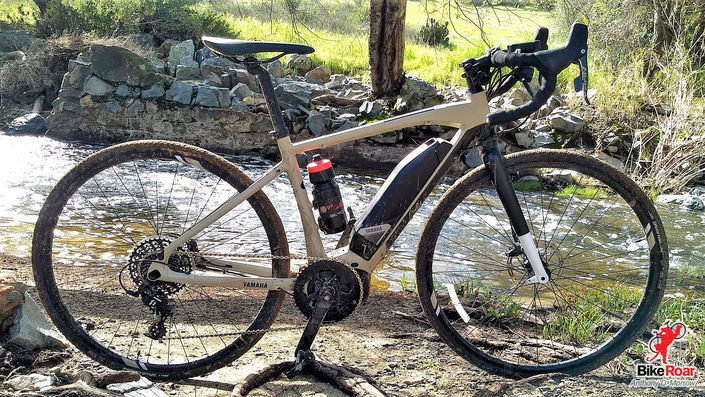
Yamaha is powering its way into the burgeoning gravel cycling category with today's launch of its all-new adventure gravel e-bike, the Wabash, a Class 1 power assist / pedelec electric bicycle developed from frame to motor by Yamaha Bicycle.
The Wabash, announced five months ago at Interbike 2018, followed a year after Yamaha Motor Corp., USA introduced its own line of four electric bicycles to North America at Interbike 2017: the CrossConnect commuter/utility bike, the CrossCore fitness bike, the UrbanRush drop-bar road bike, and the YDX-TORC performance hardtail e-mountain bike. Yamaha's overall e-bike prowess goes back over 25 years, having invented the world's first electrically power assisted bicycle (PAS) for Japan in 1993. Since then, they've sold more than 2 million Yamaha e-bikes and produced more than 4 million drive units for other brands (including Giant, Haibike, and BH/Emotion).
Enter Wabash, slotting nicely into Yamaha's e-bike line up and addressing two cravings of many of today's bicycle consumers.
"The gravel category is growing because of the performance and versatility built into these bikes," said Drew Engelmann, Yamaha's Power Assist Bicycle group sales and marketing manager.
"The Wabash brings together the biggest growth segment in cycling – e-Bikes – with one of the hottest trends in cycling – gravel," said Rob Trester, who leads the Yamaha Power Assist Bicycle group in the U.S.
Now here are Wabash details and if we think it can earn a spot in your stable of two-wheeled steeds.
Build and Specs
The Wabash frame is hydroformed aluminum with internal cable routing and is fender, rack, and dropper-post (internal or external) compatible. Fork is one-piece aluminum. The frame was designed specifically for Yamaha's PW Series SE mid-drive unit.
Yamaha say they're the only brand that produces the frame and power assist unit and that it allows them to make bikes that fit and ride better. Along with some extra space afforded by a side-mount battery, Wabash has the lowest standover height of Yamaha's 700c models and a low center of gravity well-suited for cornering and control.
The Wabash frame comes in three sizes: small (effective top tube 530), medium (550), and large (580), each with size-specific handlebars, stems, seatposts, and crank arms.
The PW Series SE drive can be turned off completely or turned on to assist at four power levels – ECO+, ECO, STANDARD, HIGH – providing speed support up to 20 mph, cadence support up to 110 RPMs, and max power of 500 watts, max torque of 70Nm.
Powering the motor is Yamaha's 500Wh 36V lithium-ion battery. Using the included High Speed Charger, it can be fully charged in about 4 hours, on or off the bike. This gives the bike a range of about 78 miles in ECO+ Power Assist Mode, but that's a rough figure highly affected by the amount of pedaling power the rider contributes and the terrain.
Drivetrain (other than the Yamaha motor), shifting, and braking are SRAM APEX 1. Since it's a 1x, there's no front derailleur and the left controller is for braking only. Brakes are hydraulic with flat-mount calipers and 160 mm center lock rotors. Gearing is 11-42t by SRAM PG-1130 cassette. Chainring is SRAM X-Sync and chain is KMC's e-bike specific X11e, built for the higher loads that come from the electric motor.
Handlebars flare by 10 cm at the bottom of the drop, providing more stability, control, and position versatility for roads and trails. The wider drop also allows for easier incorporation of handlebar packs for bike-packing adventure trips.
Mounted to the bars are the ruggedized monochrome backlit display, ergonomic controller, 200 lumen LED headlamp, and a small thumb-strike bell. The display shows: speed, average speed, maximum speed, trip distance, odometer, cadence, battery capacity (%), and clock. On top of the LCD is a multi-color LED light that changes color as a quick-look indicator of your power assist level. The display has Bluetooth connectivity so you can pair it to aftermarket power and cadence meters and/or an app like Ride with GPS. Bluetooth can be set to CSCP (Cycling Speed and Cadence Profile) or CPP (Cycling Power Profile) for use with an app like Strava. There's also a USB Micro-B charge port at the bottom so you can charge your phone or other accessories.
Wheels are thru axle hubs, 700c x 25 mm box style rims, Presta valve, tubeless ready, 32-hole front and rear, with standard J-bend spokes and brass nipples; they're ready for off-road and made for durability, compliance, and ease of service.
Tires are Maxxis Speed Terrane 700 x 33c TR EXO. They're tubeless ready with finer tread pattern in the middle and larger knobs to the sides.
Altogether, Wabash is 42.3 lbs. (19.2 kg) in size large – about 7 pounds battery, 8 pounds motor, and 27 pounds for the rest of the bike.
(If you still want to know even more, see our full specifications page.)
What do you think of Wabash? How does it ride?
Wabash's styling compliments its versatility, which is to say it's a little conservative so as to look like it belongs on or off-road. This includes its one available color, Latte; beige with black and white accents. It's clearly an e-bike from the large black battery and motor, but if you imagine Wabash without those, it's mostly a regular and fine looking bike.
We rode the Wabash as part of a sneak preview group through North County, San Diego. It was a pretty complete route to put the bike through its paces on and off-road: pavement, trails, singletrack, gravel, dirt, sand, rocks, through mud and water, up steep climbs, and rushing down all of the same.
First thing I noticed when I started pedaling the Wabash is it didn't seem so heavy on flat pavement. I pedaled around to check everything before rolling out for the day. The bike moved smoothly and felt balanced, and with the power assist off, I couldn't feel any drag or resistance from the motor.
The controller and display are easy to read and figure out. It was a cold morning, so I had medium thick full-finger gloves on and had no problem pushing buttons.
It was easy to see from the display's colored LED if power assist was on, though the colors were the same for both lower modes (green) and the two higher modes (blue). You can't tell exactly which of the modes just from the light and have to look at the LCD to know for sure. It was fun to look over at the LED color of other riders to see how much assist they were using to compare efforts. Distinct LED colors for each of the assist levels would be more helpful.
Yamaha's drive unit has a lot of punch, kicks in quickly, and is smooth and quiet. As I got familiar with it through the ride, I could feel how Yamaha's Triple Sensor System (measuring rider power generation, bike rolling speed, and pedal RPMs) contributed to how the motor assisted. The power assist level matters and so does how much pedaling speed and power the rider is putting out. With power assist, being over-geared (low cadence, more force) isn't as big a problem as on a regular bike, so I wasn't shifting as well as I should have. When I started shifting better and kept at more standard cadences, pedal assist felt best and most effective.
Does power assist work? Of course! Going up hills became as easy as I was willing to press up the four assist levels. I tried turning off power assist up a climb and my legs felt the full weight and challenge of the bike. I was typically in no less than the lowest assist level on climbs and rollers, which felt like it was offsetting the bike's weight and maybe a little extra. By keeping assist low, it was trying to make sure I still got a workout and didn't feel as guilty ‘cheating' on an e-bike.
Power assist changes technical riding, too. There were section where I might have slowed and lost balance and have to put a foot down. With power assist, I was able to kick out of some of those spots and keep rolling.
That power can also get you in trouble. In one case I had assist on full blast up a steep, rocky climb. I had so much speed going up that I nailed a large rock that I normally would've maneuvered around, resulting in a pinch flat. Big props to the wheels for handling that impact and other abuse quite well.
That brings us to Wabash's tires, tubeless ready 700x33s which are certainly adequate for a range of terrain. They are tilted towards road and gravel and lighter trail use and that matches the kind of riding this bike is likely to see most of the time. The tires felt a bit small and overinflated at speed and on some sections of slippery mud, sand, and rocks. Wabash's frame and fork clearance look like you could fit 40s in there, but you could also keep the stock tires and run lower pressure for more grip by going tubeless. The tires and rims are tubeless ready.
Handling and ride experience were great. I moved the bike around under me a lot, throwing it back and forth on the road and up and down trail climbs, into turns, and forward and back down drops. It felt comfortable, responsive, and steady.
I initially thought the flared handlebar drops were a little shallow – true in comparison to typical road bike bars, but not for positioning and handling off-road.
The Yamaha saddle is shaped for off-road use so that when hanging off the back, as was necessary a few times on this ride, it's less likely to catch your shorts.
Having the option to put a dropper post, internal or external cabling, is great. I don't think of a dropper as a need to have, but for many it is or a strong nice to have — and here you go.
I am not a 1X fan when it comes to strictly road, but for off-road and this bike SRAM APEX 1 is right. The 50t chainring and 11-42t cassette give a good range of gearing and rear derailleur-only shifting keeps it simple and effective. APEX shifting and braking are right on and the right balance of performance and durability for components.
I didn't like the controller behind the bars and wanted to move it out front. It might have been just something I needed to get used to, but knowing that it could be moved later is good.
I was in the drops or on the hoods, not on the tops, in many instances. I didn't feel comfortable taking my hands of the bars or moving them center to adjust my power assist level. It would be sweet if the left controller (currently just brake), could be control the power assist levels.
Overall, I enjoyed the bike a bunch. It was a fun ride that didn't have me thinking too much about the fact I was on an e-bike. That's a compliment to the geometry and design and the Yamaha guys who helped get it setup for my ride.
Here's a video of my impressions shortly after wrapping up the ride.
Who is Wabash for?
Gravel adventure is for a lot of people these days. Such a bike covers a wide swath of riding, from road to trail, making it an excellent choice for someone who want or needs to do some of each. Making it an e-bike opens it up even more, giving the rider the ability to add distance, like when commuting or longer-range touring, or power to get up taller, steeper climbs.
Some rides are turned off by anything e-bike, but those who aren't as staunchly positioned will appreciate the flexibility and options Wabash gives them. This could be a rider who wants to cover more trail than his legs can usually give, maybe because of age, lack of time to train, or health issues. It could be a friend or relative who wants to enjoy a ride with you, but wouldn't normally be able to keep your pace or distance. Or it could be a rider who usually has to drive to the nearest gravel or trailhead, but can now ride to the ride and back thanks to some power assist. It's certainly for commuters and cycle touring.
Who's it not for? E-bike haters, but even they might find themselves reconsidering after giving it a try. Yamaha is offering its dealers excellent terms to encourage them to make demo bikes available, knowing that once people try them they'll like them.
Wabash also isn't for the ends of the cycling spectrum, the aero road bikers and the uber gnar DHers. If you are a wind cheating weight weenie or a full-face, fat tire, full-suspension flyer, Wabash can't stretch to give you what those bikes will.
Where can I get one?
Yamaha is selling Wabash only to the U.S. market for now. It and Yamaha's other e-bikes can be purchased from bikes shops, e-bike shops, and powersports retailers that also sell bikes. Yamaha understands e-bikes are bicycles first and foremost and values the expertise of bicycle retailers to sell, setup, and service them. Use Yamaha's store locator to find retailers, some of whom also sell online.
Anything else I should know?
Yamaha offers an optional rear rack wired with integrated light.
The chain undergoes a lot of stress and will need to be changed around 3,000 miles or so, depending on conditions. The KMC X11e retails for around $55.
Yamaha offers a three-year warranty on the drive unit, battery, and frame, for the original or subsequently registered owner.
You can put Wabash on a typical car rack as they're usually able to handle 40-50 lbs. Just remember to remove the battery.
Wabash bikes consist of frames made in China and Yamaha drive systems from Japan. Bikes are assembled in China.
E-bike tariffs of 25% on bikes to the U.S. imported from China are already built into the $3,499 USD MSRP. It seems Yamaha has elected to absorb much of the increase to bring Wabash to market at a competitive price.
Checkout the BikeRoar Yamaha Wabash product page for more info, specs, and photos.
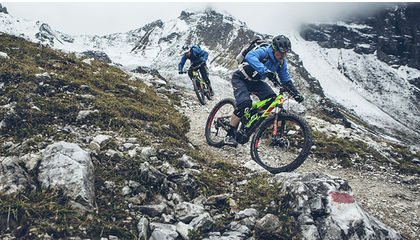
RELATED ARTICLE:
E-bikes: What there is to know before you buy
Electric bikes aren't new, but escalating popularity and ability has rules and regulations rapidly changing in response. It pays to do research before you buy and BikeRoar is here to help... READ MORE
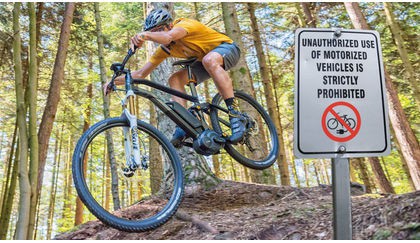
RELATED ARTICLE:
Trail Troubles: The E-Bike Controversy
Why are electric mountain bikes controversial? Are pedaling purists trying to hoard the trails? Is it something about the e-MTBs themselves? We examine the issues and offer a solution... READ MORE
